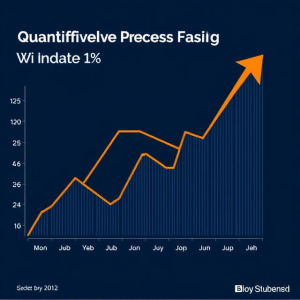Quantitative Easing Impact Analysis
Introduction to Quantitative Easing (QE)
Quantitative Easing (QE) is a non-conventional monetary policy used by central banks to stimulate economic growth by injecting liquidity into financial markets. Unlike traditional interest rate adjustments, QE involves large-scale asset purchases, primarily government bonds, to lower interest rates and encourage borrowing. This strategy gained prominence during the 2008 Financial Crisis and the COVID-19 pandemic as central banks sought to stabilize economies.

Understanding Quantitative Easing (QE)
QE aims to:
- Lower long-term interest rates
- Boost lending and investment
- Prevent deflation and stimulate inflation when necessary
- Increase money supply to support economic activity
The Federal Reserve, the European Central Bank (ECB), the Bank of Japan (BoJ), and the Bank of England (BoE) have extensively used QE in response to economic downturns.
History and Global Adoption of QE
Quantitative easing has been implemented in various forms across the world:
- Japan (2001-2006): First modern use of QE to combat deflation.
- United States (2008-2014): The Fed introduced multiple rounds of QE to aid recovery from the financial crisis.
- Eurozone (2015-2018): ECB used QE to stabilize the banking sector and stimulate inflation.
- COVID-19 Response (2020-Present): Global central banks resorted to aggressive QE policies to cushion economic shocks.
Mechanism of QE in Financial Markets
QE operates through:
- Asset Purchases: Central banks buy government or corporate bonds.
- Liquidity Injection: Newly created money increases bank reserves.
- Interest Rate Reduction: Bond yields decrease, reducing borrowing costs.
- Credit Expansion: Banks lend more, stimulating investment and spending.
Short-Term Economic Effects of QE
QE initially provides benefits such as:
✔ Increased market confidence
✔ Higher asset prices
✔ Lower borrowing costs for businesses and consumers
Long-Term Economic Implications
❌ Potential for inflation if money supply outpaces economic output
❌ Risk of creating asset bubbles
❌ Over-reliance on QE, making economies vulnerable to withdrawal effects
QE and Stock Market Reactions
Stock markets often react positively to QE due to:
📈 Lower interest rates boosting equity valuations
📈 Increased investor appetite for riskier assets
📈 Strengthened corporate balance sheets through cheap credit
QE’s Impact on Interest Rates and Borrowing Costs
- QE drives long-term bond yields lower, reducing mortgage and loan rates.
- Corporate borrowing becomes cheaper, encouraging capital investment.
- However, ultra-low rates can erode returns for pension funds and savers.
Inflationary vs. Deflationary Effects of QE
Debate exists on whether QE causes inflation:
- Proponents argue that QE helps achieve target inflation.
- Critics warn of hyperinflation risks due to excessive money supply growth.
- Japan’s experience shows QE may fail to generate inflation under weak demand conditions.
QE’s Effect on the Banking Sector
- Increased reserves but lower profit margins due to suppressed interest rates.
- Lending activity varies—some banks expand loans, while others hoard liquidity.
- Potential asset bubbles if banks overextend risk-taking.
QE and Exchange Rates: Currency Depreciation Risks
- QE often weakens domestic currency, benefiting exports but increasing import costs.
- Competitive devaluation can lead to currency wars among major economies.
- Emerging markets can suffer from capital outflows and exchange rate volatility.
QE’s Role in Economic Recovery During Recessions
QE played a critical role in:
- The 2008 Financial Crisis: The U.S. Fed launched multiple QE rounds to prevent a deep recession.
- The COVID-19 Pandemic: Massive QE programs helped stabilize markets and prevent economic collapse.
Risks and Limitations of QE
⚠ Diminishing Returns: Later QE rounds often have less impact.
⚠ Wealth Inequality: QE inflates asset prices, disproportionately benefiting the wealthy.
⚠ Exit Challenges: Scaling back QE can cause market instability.
Alternatives to Quantitative Easing
- Fiscal stimulus (government spending)
- Direct lending to businesses
- Structural economic reforms
Case Studies: Successes and Failures of QE
- Successful QE: U.S. post-2008—helped prevent depression.
- Failed QE: Japan’s 2001-2006 efforts failed to generate inflation.
- Mixed Results: The EU faced difficulties due to structural issues.
Future of QE in Monetary Policy
- Will central banks continue using QE? Likely, but with greater caution.
- Hybrid strategies may emerge, combining QE with fiscal stimulus.
- Global interest in Central Bank Digital Currencies (CBDCs) as an alternative.
Conclusion
Quantitative easing has played a pivotal role in modern monetary policy, particularly in crisis response. However, its long-term impacts remain debated, with concerns about inflation, financial instability, and inequality. Future policies may need to balance QE with fiscal measures to ensure sustainable economic growth.
FAQs on Quantitative Easing Impact Analysis
1. Does QE always lead to inflation?
Not necessarily. If money supply growth exceeds demand, inflation rises, but if demand remains weak, inflation may stay low.
2. How does QE affect the stock market?
QE boosts stock prices by lowering interest rates, making equities more attractive.
3. What are the risks of QE?
It can create asset bubbles, increase inequality, and lead to financial instability.
4. Has QE been successful?
It has helped during crises but has mixed long-term effects, as seen in Japan and Europe.
5. Can QE be reversed?
Yes, through quantitative tightening, but it risks market volatility.
6. What are the alternatives to QE?
Direct government spending, tax cuts, and regulatory reforms.